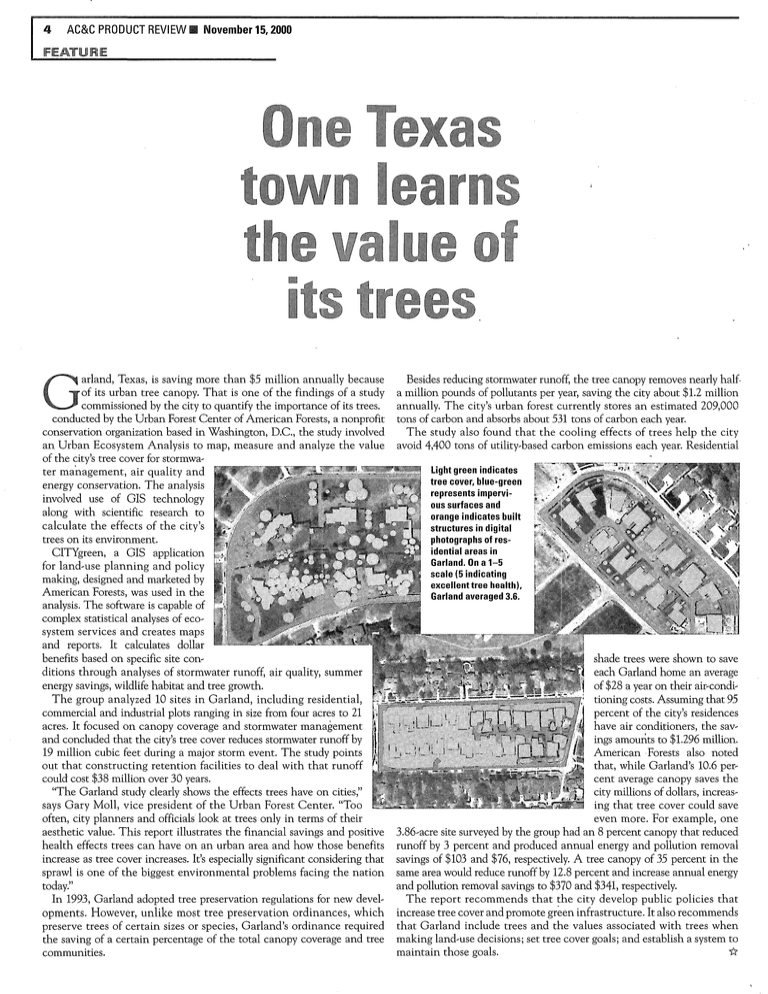
|41
AC&C PRODUCT REVIEW 1E IUovember 15, 2000
FEATURE
.
S
t0N
eIn
r_'/N arland,
Texas, is saving more than $5 million annually because
of its urban tree canopy. That is one of the findings of a study
iJ
commissioned by the city to quantify the importance of its trees.
conducted by the Urban Forest Center of American Forests, a nonprofit
conservation organization based in Washington, D.C., the study involved
an Urban Ecosystem Analysis to map, measure and analyze the value
of the city's tree cover for stormwater management, air quality and
Besides reducing stormwater runoff, the tree canopy removes nearly halfa million pounds of pollutants per year, saving the city about $1.2 million
annually. The city's urban forest currently stores an estimated 209,000
tons of carbon and absorbs about 531 tons of carbon each year.
The study also found that the cooling effects of trees help the city
avoid 4,400 tons of utility-based carbon emissions each year. Residential
_______
energy conservation. The analysis
involved use of GIS technology
along with scientific research to
calculate the effects of the citys
7
trees on its environment.
/
CITYgreen, a GIS application
for land-use planning and policy
making, designed and marketed by
American Forests, was used in the
li
analysis. The software is capable of
complex statistical analyses of eco-~
system services and creates maps
3
and reports. It calculates dollar
benefits based on specific site conditions through analyses of stormwater runoff, air quality, summer
energy savings, wildlife habitat and tree growth.
The group analyzed 10 sites in Garland, including residential,
commercial and industrial plots ranging in size from four acres to 21 ,
acres. It focused on canopy coverage and stormwater management 0
and concluded that the city's tree cover reduces stormwater runoff by ii
19 million cubic feet during a major storm event. The study points jJ
out that constructing retention facilities to deal with that runoff
E
could cost $38 million over 30 years.
"The Garland study clearly shows the effects trees have on cities," I
says Gary Moll, vice president of the Urban Forest Center. "Too S
often, city planners and officials look at trees only in terms of their
aesthetic value. This report illustrates the financial savings and positive
health effects trees can have on an urban area and how those benefits
increase as tree cover increases. It's especially significant considering that
sprawl is one of the biggest environmental problems facing the nation
today."
In 1993, Garland adopted tree preservation regulations for new developments. However, unlike most tree preservation ordinances, which
preserve trees of certain sizes or species, Garland's ordinance required
the saving of a certain percentage of the total canopy coverage and tree
communities.
shade trees were shown to save
each Garland home an average
-~~
-
-
~
of $28 a year on their air-condi-
___
tioning costs. Assuming that 95
percent of the city's residences
have air conditioners, the sav,L
)
American Forests also -noted
that, while Garland's 10.6 percent average canopy saves the
city millions of dollars, increasing that tree cover could save
even more. For example, one
3.86-acre site surveyed by the group had an 8 percent canopy that reduced
runoff by 3 percent and produced annual energy and pollution removal
savings of $103 and $76, respectively. A tree canopy of 35 percent in the
same area would reduce runoff by 12.8 percent and increase annual energy
and pollution removal savings to $370 and $341, respectively.
The report recommends that the city develop public policies that
increase tree cover and promote green infrastructure. It also recommends
that Garland include trees and the values associated with trees when
making land-use decisions; set tree cover goals; and establish a system to
maintain those goals.
COPYRIGHT INFORMATION
TITLE: One Texas town learns the value of its trees
SOURCE: American City & County 115 no16 N 15 2000
WN: 0032004687003
(C) Copyright by PRIMEDIA Intertec, A PRIMEDIA Company. All
rights reserved..
Copyright 1982-2000 The H.W. Wilson Company.
All rights reserved.



